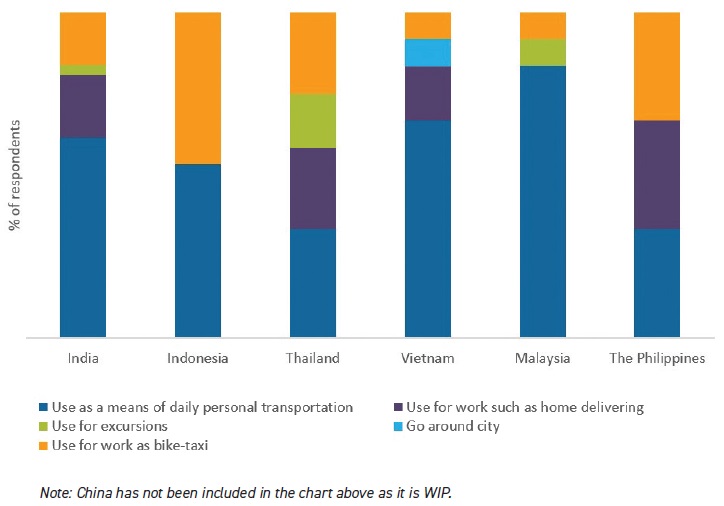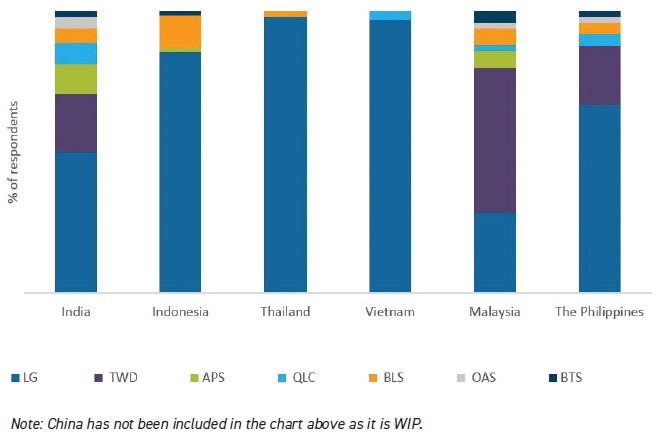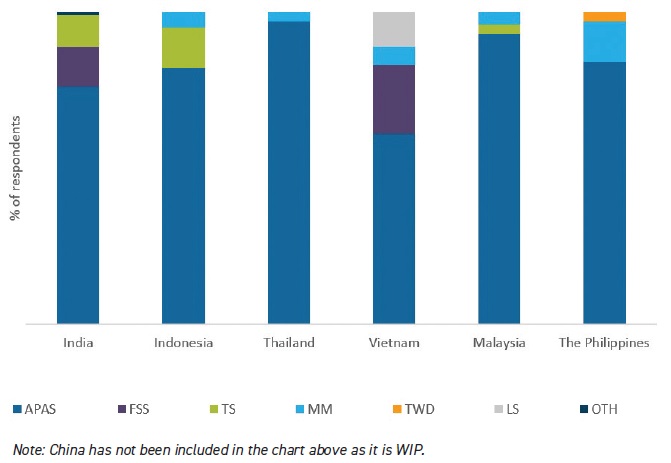Kline’s recently published report Two-Wheeler Lubricant Brands and Consumer Insights aims to understand consumer motorcycle oil (MCO) brand preference by conducting a survey among more than 2,000 respondents in China, India, Indonesia, Thailand, Vietnam, Malaysia and the Philippines. The survey, which was conducted from fourth quarter 2017 to first quarter 2018, covers both Tier-I and Tier-II cities in these countries (on the basis of population, economic and infrastructure development).
The market research study focused on three consumer groups: two-wheeler owners, two-wheeler maintenance providers and two-wheeler lubricant retailers. The two-wheeler owners survey was designed to profile the respondents into different categories:
•
Age
•
Gender
•
Vehicle type
•
Vehicle engine capacity
•
Vehicle usage type
•
Vehicle brand
•
Maintenance practice (do-it-for-me vs. do-it-yourself).
Similarly, maintenance service providers and MCO retailers are defined by:
•
Age
•
Gender
•
Industry experience
•
Designation
•
Respondent workshop or store type
•
Services
•
Products available at the respondent’s facility
•
Types of vehicles catered to.
The next step is understanding two-wheeler owners’ maintenance and vehicle usage practices. The study also includes a closer look at account attitudes related to maintenance service providers and MCO retailers’ two-wheeler lubricants business. Lastly, the report investigates MCO users’ brand awareness and preferences.
Respondent profile
The two-wheeler owners survey includes a mix of male and female respondents belonging to different age groups, household income, family size and job type. The survey finds that motorcycles are more popular, in general, than scooters or mopeds with a few exceptions. In terms of engine capacity, those up to 250 cc are more popular in these countries, as vehicles are primarily used for personal transportation. Other uses of two-wheelers include bike taxi, home delivery of products/foods, motorsport and excursions (
see Figure 1).
 Figure 1. Two-wheeler owners by use of 2W and country. (Figure courtesy of Kline.)
Figure 1. Two-wheeler owners by use of 2W and country. (Figure courtesy of Kline.)
The study includes a good mix of maintenance service providers and retailers, as can been seen from Figures 2 and 3. The two-wheeler after-sales market is divided into organized and disorganized markets. The organized market includes two-wheeler dealerships and original equipment manufacturer-authorized workshops, branded workshops of lubricant suppliers or tire suppliers, branded quick lube centers, mass merchandiser chains, fuel-filling stations and branded tire stores. The disorganized market includes local garages, lubricant stores, independent workshops, auto-parts stores, independent tire stores and local merchandisers.
 Figure 2. Service provider split by type and country. (Figure courtesy of Kline.)
Figure 2. Service provider split by type and country. (Figure courtesy of Kline.)
 Figure 3. Lubricant retailer split by type and country. (Figure courtesy of Kline.)
Figure 3. Lubricant retailer split by type and country. (Figure courtesy of Kline.)
The report identifies that the majority of the service providers not only provide maintenance services but also sell lubricants and auto parts. Moreover, most service providers do not discriminate on the basis of two-wheeler types, except for a few special workshop types.
Lubricant retailers covered in this report usually stock all types of two-wheeler lubricants; however, it is interesting to note that a few retailers sell two-wheeler engine oils as well as engine oils used in cars or trucks.
Brand awareness
Generally speaking, brand awareness and loyalty is high in Southeast Asia. Brand loyalty is measured based on the number of two-wheeler owners that reported using a particular brand since a certain period. Brand awareness is measured based on the number of two-wheeler owners reporting that they knew which brand they wanted to buy before they got to the store or workshop.
However, awareness of each brand among two-wheeler owners vary with the geography. A brand with the highest brand awareness in a particular country may or may not be the most popular brand in another country or across all the cities of the same country. The report highlights such differences between Tier-I cities and Tier-II cities for not only two-wheeler owners but also service providers and lubricant retailers.
Brand preference
The quality of a brand, mechanics’ recommendation and trust in a particular brand are cited by two-wheeler owners as the important reasons for using a brand most often. Quality is the most important factor in selecting a brand, while offers/discounts is the most important factor for selecting a supplier by maintenance service providers as well as lubricant retailers.
Media for creating brand awareness
Based on the survey, the report concludes that TV advertisements, garage mechanics and staff at workshops/stores are the most effective routes to create brand awareness for two-wheeler owners. In the case of maintenance service providers local mechanics and oil distributor representatives are considered as the most impactful.
In a nutshell, the survey helps to understand the journey of two-wheeler owners for purchasing lubricants and their key decision-making criteria for brand and supplier selection. The survey is available at
www.klinegroup.com/reports/two_wheeler_lubricant.asp.
Sushmita Dutta is Project Manager-Energy for Kline. You can reach her at sushmita.dutta@klinegroup.com.
Kline is an international provider of world-class consulting services and high-quality market intelligence for industries including lubricants and chemicals. Learn more at www.klinegroup.com.